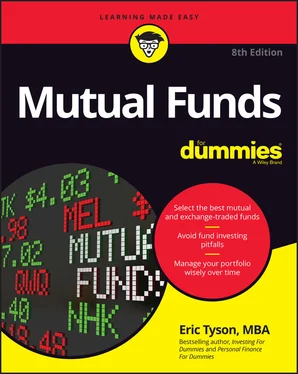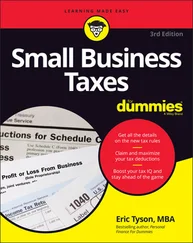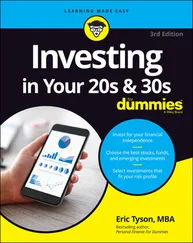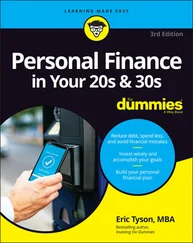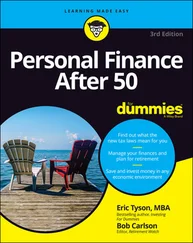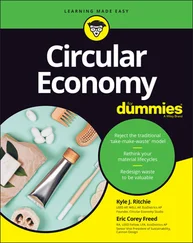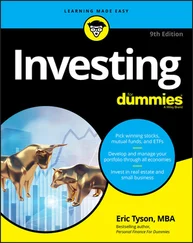Eric Tyson - Mutual Funds For Dummies
Здесь есть возможность читать онлайн «Eric Tyson - Mutual Funds For Dummies» — ознакомительный отрывок электронной книги совершенно бесплатно, а после прочтения отрывка купить полную версию. В некоторых случаях можно слушать аудио, скачать через торрент в формате fb2 и присутствует краткое содержание. Жанр: unrecognised, на английском языке. Описание произведения, (предисловие) а так же отзывы посетителей доступны на портале библиотеки ЛибКат.
- Название:Mutual Funds For Dummies
- Автор:
- Жанр:
- Год:неизвестен
- ISBN:нет данных
- Рейтинг книги:3 / 5. Голосов: 1
-
Избранное:Добавить в избранное
- Отзывы:
-
Ваша оценка:
- 60
- 1
- 2
- 3
- 4
- 5
Mutual Funds For Dummies: краткое содержание, описание и аннотация
Предлагаем к чтению аннотацию, описание, краткое содержание или предисловие (зависит от того, что написал сам автор книги «Mutual Funds For Dummies»). Если вы не нашли необходимую информацию о книге — напишите в комментариях, мы постараемся отыскать её.
Mutual Funds For Dummies
Mutual Funds For Dummies
Mutual Funds For Dummies — читать онлайн ознакомительный отрывок
Ниже представлен текст книги, разбитый по страницам. Система сохранения места последней прочитанной страницы, позволяет с удобством читать онлайн бесплатно книгу «Mutual Funds For Dummies», без необходимости каждый раз заново искать на чём Вы остановились. Поставьте закладку, и сможете в любой момент перейти на страницу, на которой закончили чтение.
Интервал:
Закладка:
TABLE 5-1The Companies of the Standard & Poor’s 500 Index at the End of 1999
| Stock | Rank in Index | Market Value | Percent of Index |
|---|---|---|---|
| Microsoft Corp | 1 | $604,078 | 4.92% |
| General Electric | 2 | $507,734 | 4.14% |
| Cisco Systems | 3 | $366,481 | 2.99% |
| Walmart Stores | 4 | $307,843 | 2.51% |
| Exxon Mobil | 5 | $278,218 | 2.27% |
| Intel Corp | 6 | $274,998 | 2.24% |
| Lucent Technologies | 7 | $234,982 | 1.91% |
| IBM | 8 | $194,447 | 1.58% |
| Citigroup Inc. | 9 | $187,734 | 1.53% |
| America Online | 10 | $169,606 | 1.38% |
Seeing the pros and cons of trading ETFs
One supposed advantage of trading ETFs is that, unlike the regular index mutual funds I recommend in this book, you can trade (buy or sell) ETFs throughout the weekdays when the stock market is open. When you buy or sell an index mutual fund, your transaction occurs at the closing price on the day that you place the trade (if the trade is placed before the market closes).
 Sure, the flexibility of ETFs sounds alluring, but consider a few drawbacks:
Sure, the flexibility of ETFs sounds alluring, but consider a few drawbacks:
Timing your moves in and out of the stocks: Being able to trade in and out of an ETF during the trading day isn’t a necessity, nor is it even a good practice. In my experience of working with individual investors, most people find it both nerve-racking and futile to try to time their moves in and out of stocks with the inevitable fluctuations that take place during the trading day. In theory, traders want to believe that they can buy at relatively low prices and sell at relatively high prices, but that’s far easier said than done.
Paying a brokerage commission every time you buy or sell shares: With no-load index funds, you generally don’t pay fees to buy and sell. But with ETFs, because you’re actually placing a trade on a stock exchange, you pay a brokerage commission every time you trade through some brokers. For example, if you buy an ETF with a seemingly low expense ratio of 0.1 percent and you pay $10 to trade the ETF through an online broker, that’s equal to paying two years’ worth of management fees if you invest $5,000 in the ETF!
Figuring out whether the current price on an ETF is above or below the actual value of the securities it holds: Because ETFs fluctuate in price based on supply and demand, when placing a trade during the trading day, you may face the uncertainty and complication of trying to determine (if you care) whether the current price on an ETF is above or below the actual value of the securities it holds. With an index fund, you know that the price at which your trade was executed equals the exact market value of the securities it holds.
 Because ETFs trade like stocks, you can use limit orders and stop loss orders as well as sell them short or trade them on margin. I generally don’t recommend these strategies for nonprofessional investors.
Because ETFs trade like stocks, you can use limit orders and stop loss orders as well as sell them short or trade them on margin. I generally don’t recommend these strategies for nonprofessional investors.
Identifying the best ETFs
The vast majority of investors don’t need to complicate their lives by investing in ETFs. Use them if you’re a more advanced investor who understands index funds and you have found an ETF that’s superior to an index fund you’re interested in or use a highly suitable and well-established ETF as a long term core position. But do not use ETFs to make short term bets, which is a fool’s game.
BEWARE OF “FINANCIAL ADVISORS” IN LOVE WITH ETFs
I began work as a financial advisor in 1990. I was just about the only practitioner at the time who worked solely on an hourly basis. Most of the fee-based advisors at that time managed their clients’ portfolios by using mutual funds. I was struck by the fact that many advisors didn’t use or recommend low-cost index funds. In speaking with some of these advisors, I got the sense that they were somewhat threatened by index funds because the investing process was so simplified that clients might question the value in paying the advisor an ongoing fee of about 1 percent to manage their money among funds.
Interestingly, some advisors now boast that they use ETFs as the investment vehicle to manage their clients’ portfolios. Ironically, they crow about the low cost of ETFs. Why do some advisors now embrace and tout ETFs when they didn’t advocate index funds? ETFs are complicated, and advisors feel safer using them and don’t worry as much about having clients feel that they could do this on their own. Advisors who charge ongoing management fees while using ETFs aren’t performing low-cost investment management. If the ETFs they’re using average about 0.5 percent in annual fees, paying the advisor 1 percent per year on top of that to shift your money around among various ETFs triples your total costs! See Chapter 23for how to find a good advisor.
 Be sure to check whether the ETF you’re considering is selling at a premium or discount to its net asset value. (You can find this information on the ETF provider’s website after the market’s close each business day.) I strongly encourage you to employ the buy-and-hold mentality that I advocate throughout this book — don’t hop in and out of ETFs. You should also buy only the ETFs that track the broader market indexes and that have the lowest expense ratios. Avoid those that track narrow industry groups or single, smaller countries. See Chapters 11through 15for specific ETFs that I like for specific situations.
Be sure to check whether the ETF you’re considering is selling at a premium or discount to its net asset value. (You can find this information on the ETF provider’s website after the market’s close each business day.) I strongly encourage you to employ the buy-and-hold mentality that I advocate throughout this book — don’t hop in and out of ETFs. You should also buy only the ETFs that track the broader market indexes and that have the lowest expense ratios. Avoid those that track narrow industry groups or single, smaller countries. See Chapters 11through 15for specific ETFs that I like for specific situations.
 If you’re truly interested in investing in ETFs and you’re a more advanced investor, make sure you know which funds are the best ETFs. The best ETFs, like the best index funds, have low expense ratios. My top picks among the leading providers of ETFs include the following:
If you’re truly interested in investing in ETFs and you’re a more advanced investor, make sure you know which funds are the best ETFs. The best ETFs, like the best index funds, have low expense ratios. My top picks among the leading providers of ETFs include the following:
Vanguard: Historically, Vanguard has been the low-cost leader with index funds and now has the lowest cost with its ETFs as well. So, if you’re interested in finding out more about ETFs, be sure to examine Vanguard’s ETFs. ( www.vanguard.com ; 800-662-7447)
iShares: BlackRock has competitive expense ratios on some domestic ETFs based on quality indexes, such as Russell, Morningstar, S&P, Lehman, and Dow Jones. ( www.ishares.com ; 800-474-2737)
State Street Global Advisors SPDRs: This group uses indexes from Dow Jones, S&P, Russell, and MSCI, among others. ( www.ssgafunds.com ; 866-787-2257)
Mimicking Closed-End Funds: Unit Investment Trusts
Unit investment trusts (UITs) have much in common with closed-end funds (see Chapter 2). UITs take an amount of money (for example, $100 million) and buy a number of securities (such as 70 large-company U.S. stocks) that meet the objectives of the UIT. Unlike a closed-end fund (and mutual funds in general), however, a UIT does not make any changes to its holdings over time — it simply holds the same, fixed portfolio. This holding of a diversified portfolio can be advantageous because it reduces trading costs and possible tax bills.
Читать дальшеИнтервал:
Закладка:
Похожие книги на «Mutual Funds For Dummies»
Представляем Вашему вниманию похожие книги на «Mutual Funds For Dummies» списком для выбора. Мы отобрали схожую по названию и смыслу литературу в надежде предоставить читателям больше вариантов отыскать новые, интересные, ещё непрочитанные произведения.
Обсуждение, отзывы о книге «Mutual Funds For Dummies» и просто собственные мнения читателей. Оставьте ваши комментарии, напишите, что Вы думаете о произведении, его смысле или главных героях. Укажите что конкретно понравилось, а что нет, и почему Вы так считаете.
